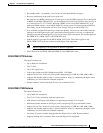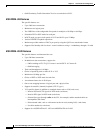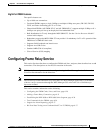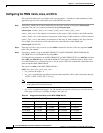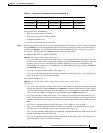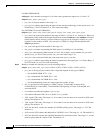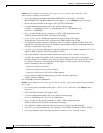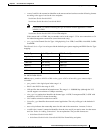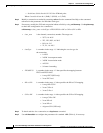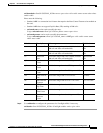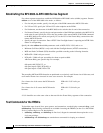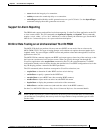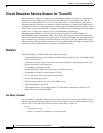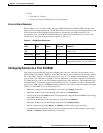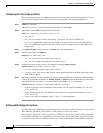
6-33
Cisco MGX 8230 Edge Concentrator Installation and Configuration
Release 1.1.31, Part Number 78-11215-03 Rev. B0, May 2001
Chapter6 Card and Service Configuration
Configuring Frame Relay Service
• remoteConnID is the connection identifier at the remote end and can have one the following formats
according to the type of card at the slave endpoint:
NodeName.SlotNo.PortNo.DLCI
NodeName.SlotNo.PortNo.ControllerId.DLCI
Note ControllerId is a number indicating the type of network control application: 1=PAR,
2=PNNI, 3=TAG.
NodeName.SlotNo.PortNo.VPI.VCI for ATM endpoint
If the remote end is a PXM1, the port number can be in the range 1–32 for user connections or 34
for inband management connections (stand-alone node only).
• serv_type is the Channel Service Type: 1=high priority, 2=rt-VBR, 3=nrtVBR, 4=fstABR, 5=uBR,
9=stdABR
The Channel Service Type is used to provide the default egress queue mapping and PXM1 Service Type
mapping:
For MGX-FRSM-HS1/B:
addcon <port_number> <DLCI> <CIR> <chan_type> <CAC> <Controller_type> <mastership>
<connID>
• port_number is the logical port in the range 1–4.
• DLCI is the DLCI in the range 0–1023.
• CIR specifies the committed information rate. The range is 1–10000000 bps (although the V.35
version supports a maximum of 8 Mbps sustained).
• chan_type is a number that identifies the channel type: 1=NIW; 2=transparent SIW; 3=SIW with
translation; 4=FUNI; 5=frame forwarding.
• CAC enables connection admission control.
• Controller_type identifies the network control application. The only valid type is the default of 1
(PAR).
• mastership indicates the mastership status for this end of the connection: 1=master; 2=slave.
• connID is the “remote” connection identifier from the slave end if you need to enter it at the master
end. See “Rules for Adding Connections” for an explanation. The possible formats are:
–
NodeName.SlotNo.PortNo.DlCI
–
NodeName.SlotNo.PortNo.ControllerId.DlCI for Frame Relay end point.
Service Type Default EgressQueue PXM1 Service Type
HighPriority Hi Priority CBR
VBR-RT Hi Priority VBR-RT
VBR-NRT Low Priority VBR-NRT
ABR-FS Low Priority ABR-FST
STD-ABR Low Priority ABR-STD
UBR Low Priority UBR



